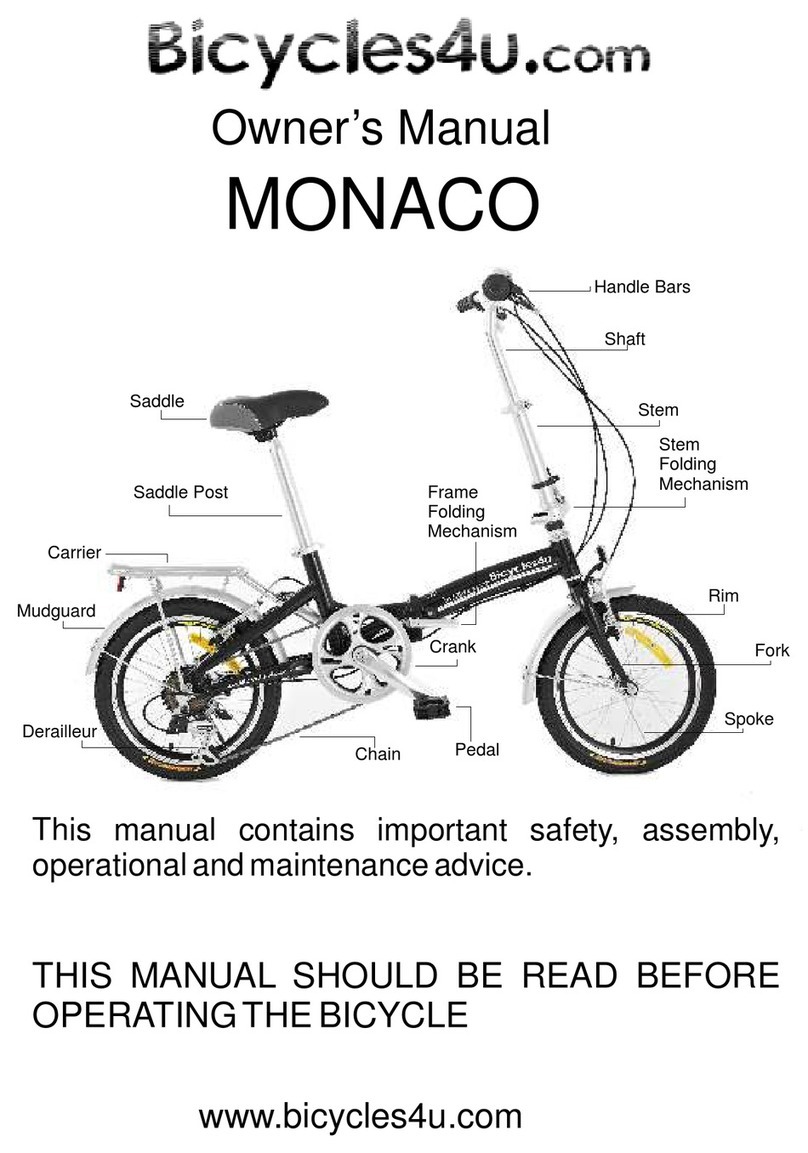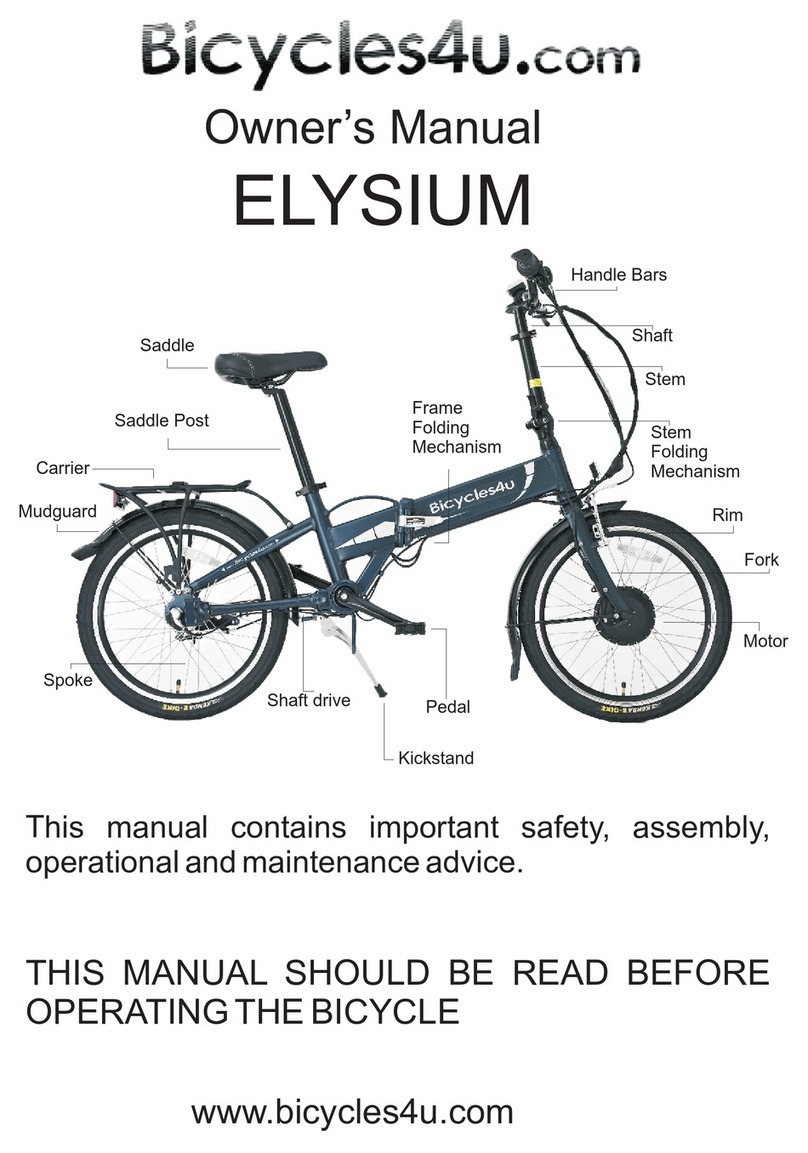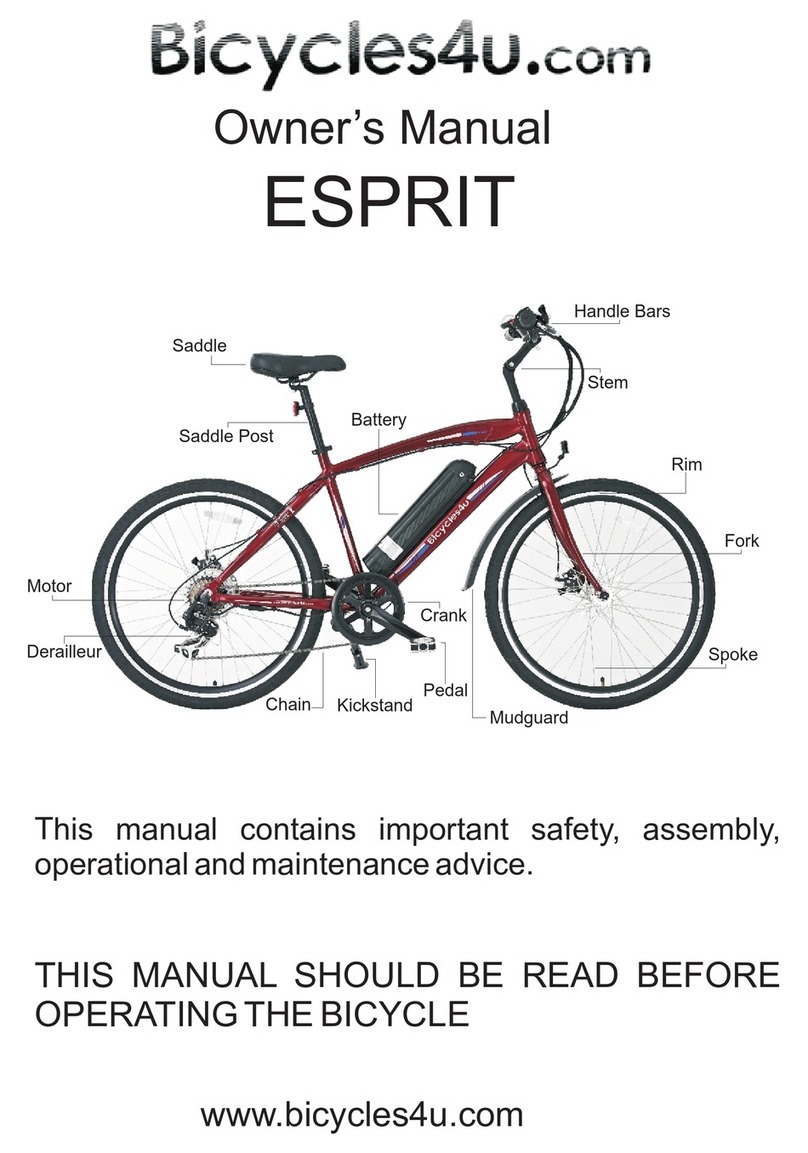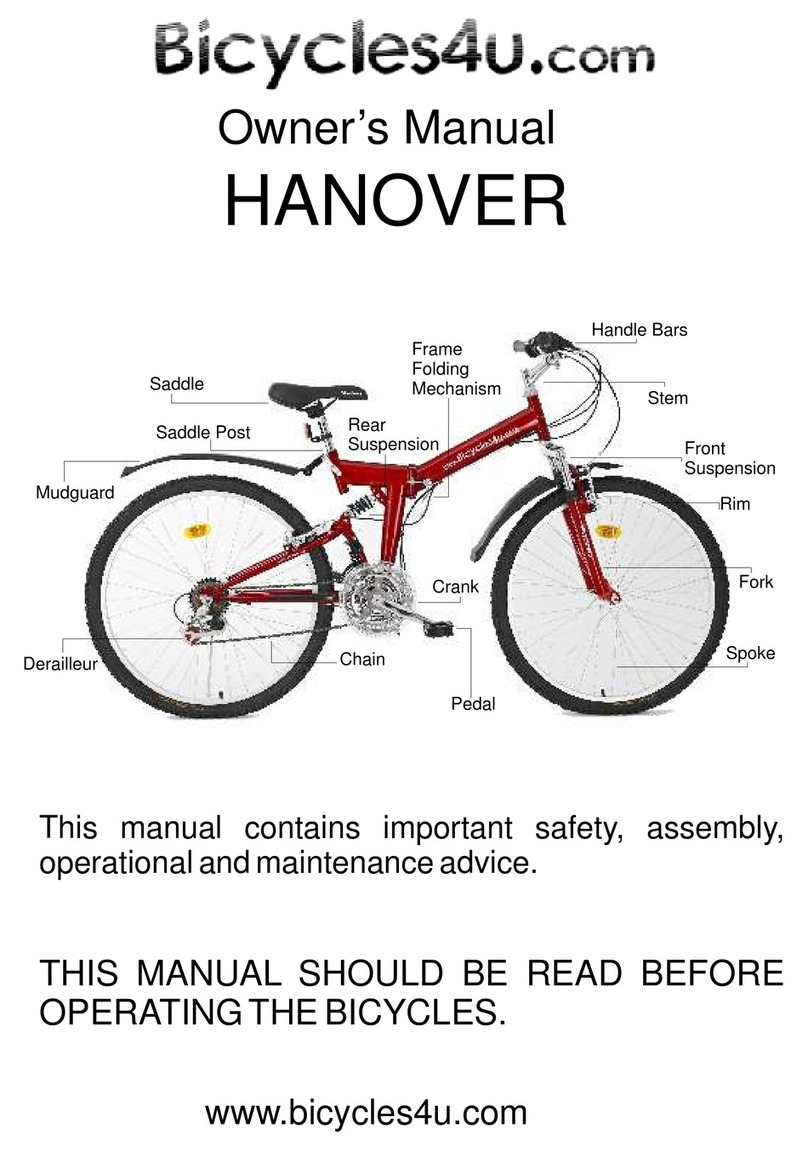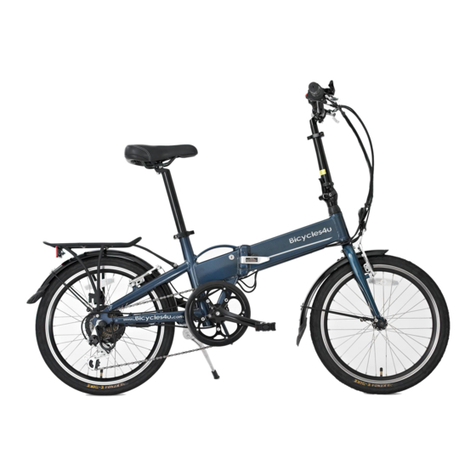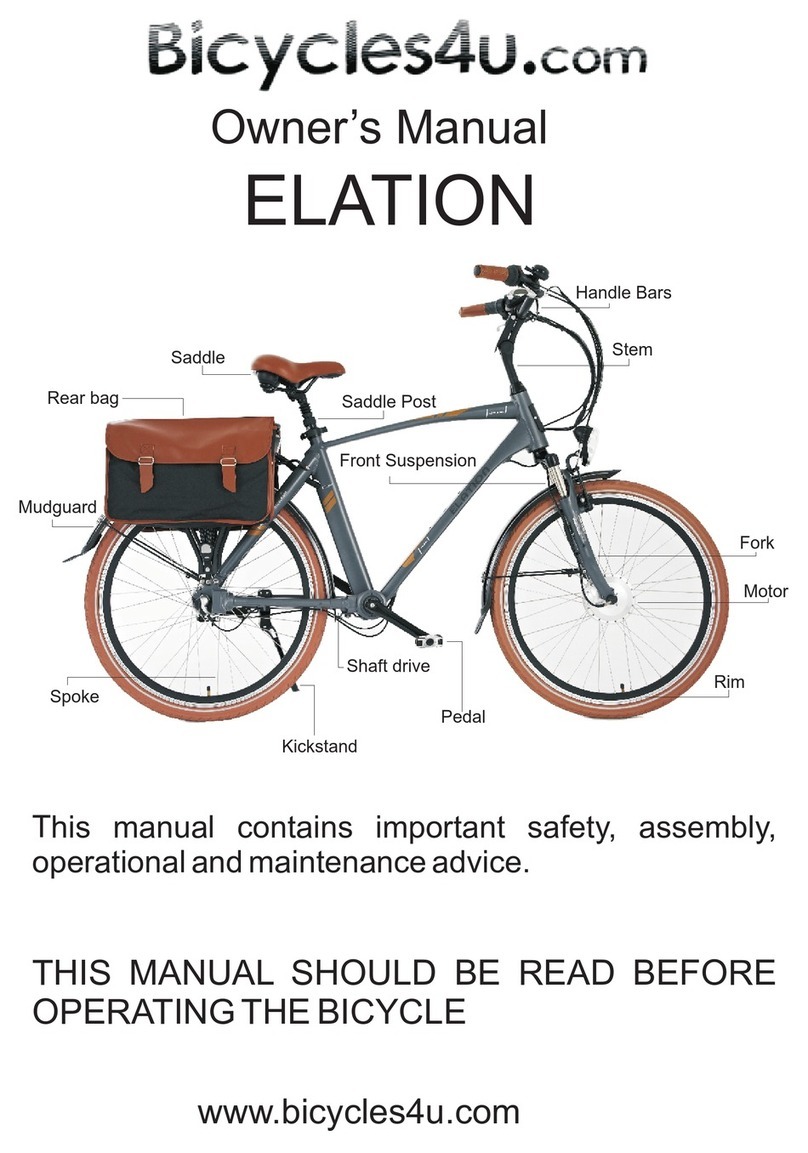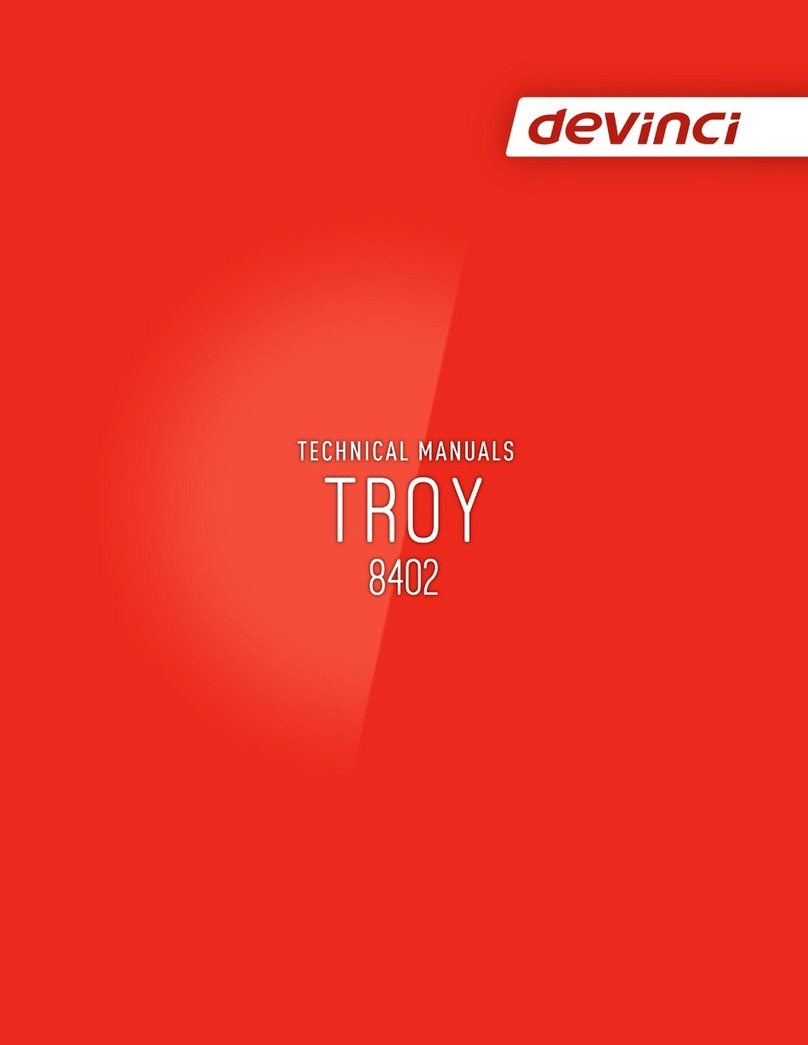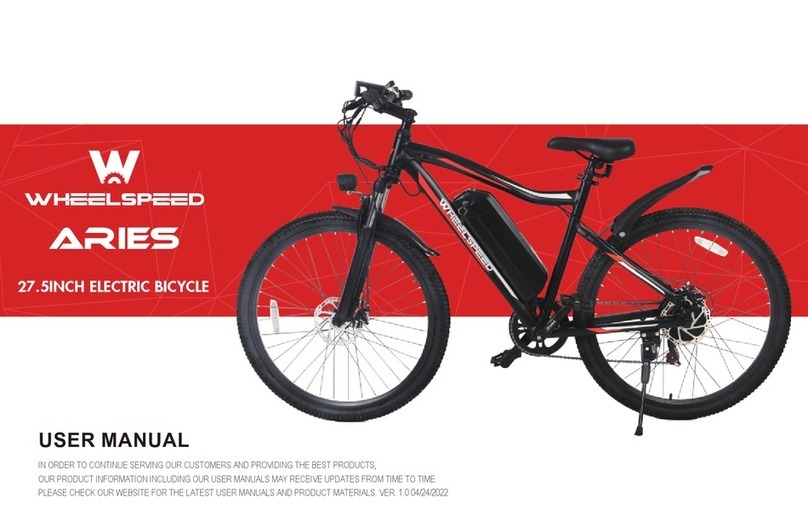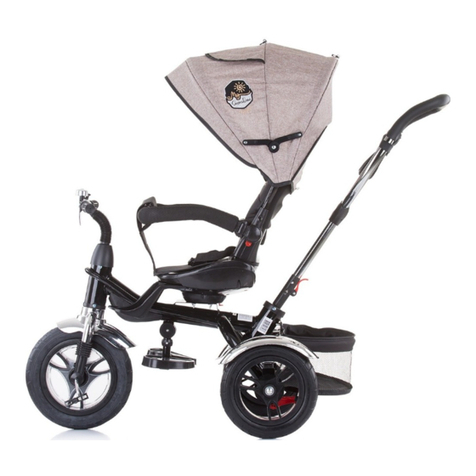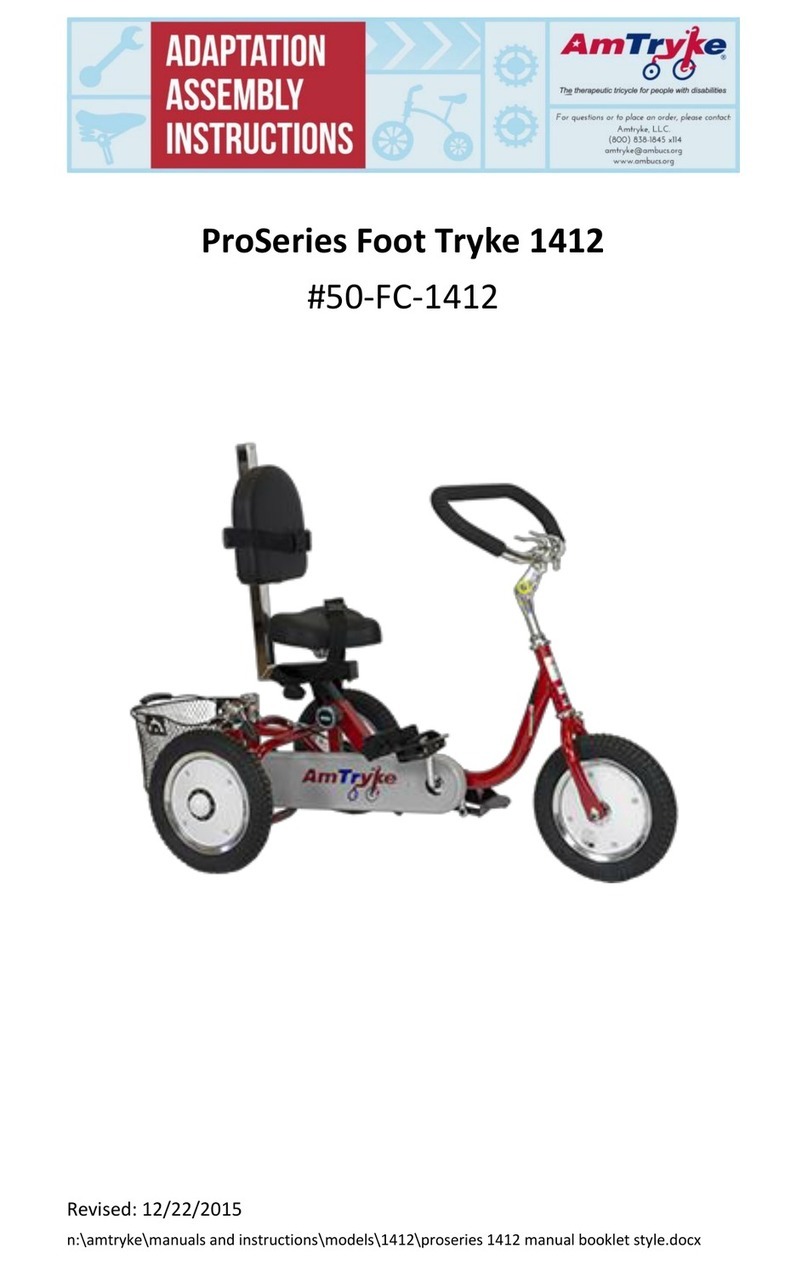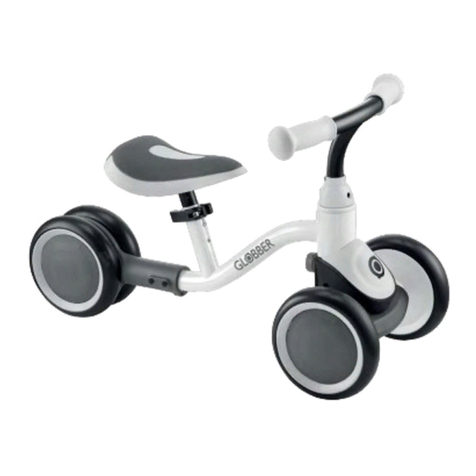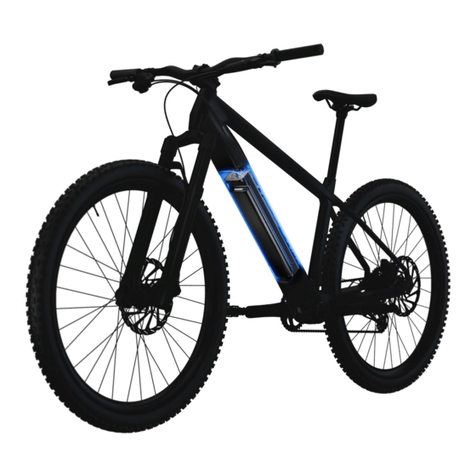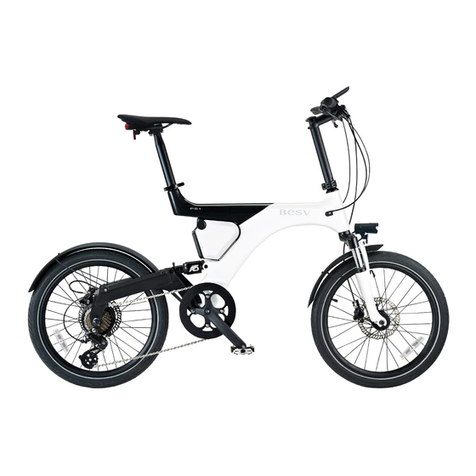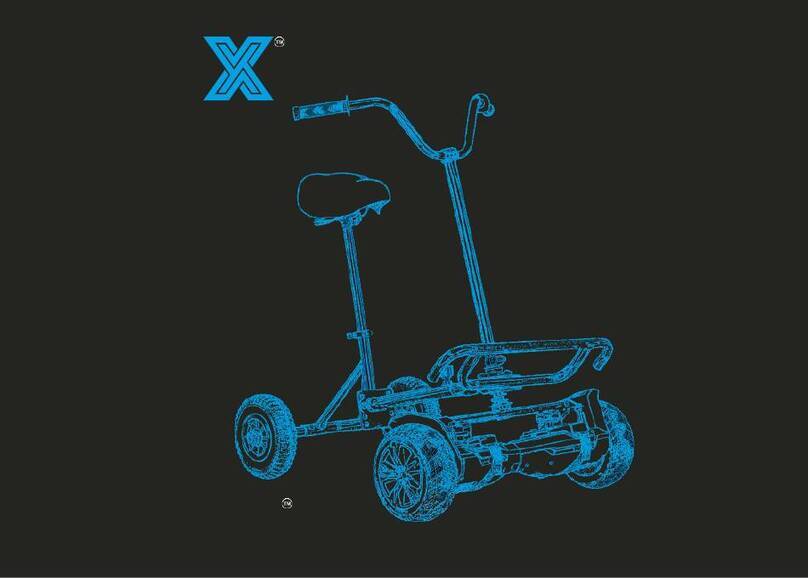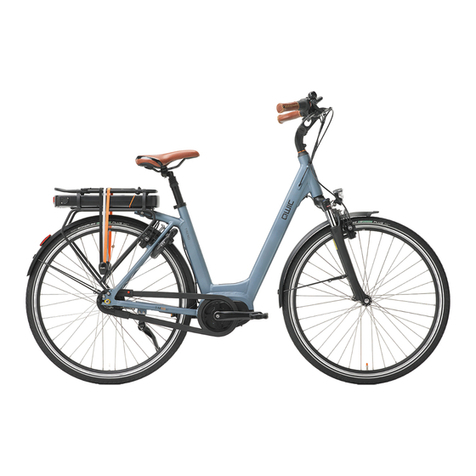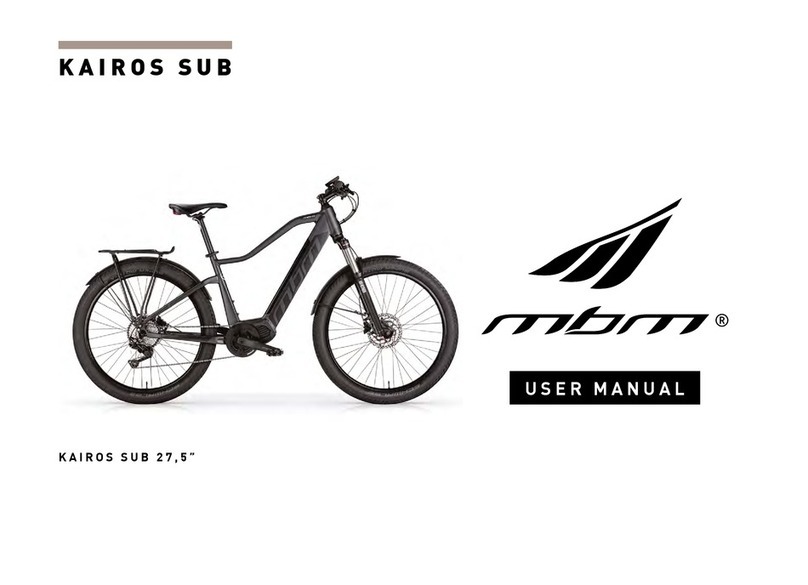Bicycles4u City Zoom User manual

City Zoom
Owner’s Manual
This manual contains important safety, assembly,
operational and maintenance advice.
THIS MANUAL SHOULD BE READ BEFORE
OPERATING THE BICYCLE.
Saddle Post
Saddle
Front bag
Mudguard
Derailleur
Pedal
Handle Bars
Fork
Crank
Chain
Rim
Motor
www.bicycles4u.com
Handle Bars
Saddle
Derailleur
Crank
Saddle Post
Chain Pedal
Mudguard
Rim
Battery
Fork
Frame
Handle Bars
Stem
Handle Bars
Stem

1) Do not operate the e-bike before reading this user manual thoroughly. The manufacturer will not be
held responsible for any damage or accident due to improper use.
2) For your safety and others please follow the traffic regulations. This bicycle is not suitable for children
under thirteen and the disabled. This e-bike is not recommended for competition, stunts or off-road riding.
3) Do not lubricate the brakes.
4) The braking length of a dry state surface/road is 4 meters at 25km/h, while 15 meters in wet state. So,
move slowly, keep a safe distance from other vehicles/objects around you and brake in advance where
necessary while riding downhill and in rain, snow & wet road.
5) To ensure your safety please use helmets, check brakes & tyres, handlebars and rims before riding.
6) Maximum rider weight: 115 Kg.
Maximum carrier weight: 15 Kg.
7) Improper use could cause harm, please check the connection of the frame, stem and suspension
periodically. Every mechanical part has friction and pressure. Different materials and parts have different
frictions and pressures. If a mechanical part has exceeded its service life, resultant damage could hurt the
user.
8) Do not ride in water where the depth exceeds the controller. The motor or directly flush water to
electrical components.
9) Avoid prolonged exposure to the sun or rain and exposure to humid places. Aggressive gases may
cause parts to corrode or electrical parts to fail. This can lead to malfunctioning or accidents.
10) This product contains advanced electrical components built in to the structure. Please do not
disassemble or modify any part of it.
11) The performance and mileage of the unit will be varied depending on the battery condition,
temperature, terrain, wind speed, tyre pressure, rider weight and the maintenance, etc. To get the best
mileage we propose that:
(1). Ride for 3-5m in power mode when starting.
(2). Try to reduce frequent braking or restarts.
(3). Ride in PAS mode while on uneven road conditions, uphill or headwind.
(4). Avoid carrying people or overloading
(5). Check the tyres before riding to ensure they have the correct pressure.
User Security
Regular check’s for safety before riding
1) Check if the handlebar stem and saddle post are safely inserted. Take note of the maximum height
markings (MIN. INSERTION) on the tube.
2) Check the brake shoes for excess wear. If there is wear, you should replace them before riding.
3) Check if the nuts on the front and rear axis are securely fixed.
4) Check the pedals and other fixtures for any signs of damage. Check if the rotary parts move freely.
5) Check the tyre pressure in accordance with the markings and check for ample treads on the tyre. If they
are excessively worn replace them immediately.
6) Make sure that you know how to operate the e-bike and clearly know all the traffic regulations.
7) Check if the brake and the power function are working well.
(1). Stand the bike on the kickstand, switch to the electric mode and then slowly turn the throttle. If the
motor does not work, then the kickstand can cut the power efficiently.
(2). Close the kickstand, switch to the electric mode and then apply the brake. If the motor does not work,
then the brake can cut the power efficiently.
9) Check if the grip throttle functions well. Check if it goes back into place immediately after releasing it.
10) Check all electrical connections and mechanical parts are securely locked, check all cables, connector
plugs and sockets must be dry and undamaged.

Battery and charging
Instructions on the bike operation
1) Press the power switch on the
battery to turn the power on, the
indicator light(s) will show.
3) MED power assistant mode
will have a top speed of 20km/h.
5)By pressing “+” until the three lights stop
showing(Low,Med,High)means that the power
assist is turned off and you can use the “6km/h”
button to power the bike.
1. 2.
3. 4.
5. 6.
2) LOW power assistant mode
will have a top speed of 15km/h.
4) HIGH power assistant mode
will have a top speed of 25km/h.
6) To turn the power off close
the power switch.
No battery indicator lights
should be on.
How to Remove the Battery
1)
2) Remove the battery from the frame.
1) Push the battery into the frame.
2) Use the key to lock the battery.
Unlock the battery using the key.
How to Replace the Battery
1) Use the power switch which is
located on the side of the battery
to turn the power ON and OFF.
2) Use the key to lock or unlock the
battery from the frame.
.
6km/h
EMPTY
FULL
LOWMED HIGH
_
+
6km/h
EMPTY
FULL
LOWMEDHIGH
_
+
6km/h
EMPTY
FULL
LOWMED HIGH
_
+
6km/h
EMPTY
FULL
LOW MED HIGH
_
+
6km/h
EMPTY
FULL
LOWMEDHIGH
_
+
6km/h
EMPTY
FULL
LOWMEDHIGH
_
+

Steps to charge the battery
1) Confirm that the local power supply corresponds with the requirement of the charger.
The input voltage is between 100V-240V.
2) The battery can be charged on the e-bike or removed from the e-bike and charged
separately.
3) Connect the charger plug and charging port of the battery first and then connect the
power plug and the power source.
4) When the red light turns on, the charging starts.
Safe charging
Taking care of the battery is vital to ensure your safety
and to maximize its long term performance. Battery fault,
fire or explosion hazards will occur if the instructions are
not followed:
Ensure that the charger plugs are dry
and securely connected to the charger port of the
battery case.
Do not cover the battery or charger while charging. Do not use
the battery charger near flammable products or in unventilated
places. The ambient temperature should not exceed 40°C.
Keep the battery away from water to prevent shocks or shorting.
Only use the charger provided to charge the battery.
Do not disassemble or modify the battery.
Do not expose the battery to fire or extreme temperatures.
Do not allow impact or force against the battery pack.
Pull out the power plug first and then the charger plug after charging. Connecting the
power plug and the power source for a long time while not charging is not recommended.
If any abnormal conditions occur, like overheating or strange smells, stop charging
immediately and contact your authorized dealer for help.
Keep the charger in a safe place and away from children.
Regular use - if you are commuting significant distances, it is advisable to recharge the
battery before the return journey.
Occasional use - Recharge the battery at least once a week, even if the e-bike is not
used.
Always recharge the battery after use.
The manufacturer will not be responsible for any damage or injury due to
improper or unsafe use of the battery charger
LED Indication
1) LED (GREEN) - Power on, when not connected to the batteries.
2) LED (RED) - Charging.
3) LED (GREEN) - Fully charged, when connected to the batteries.
Power Plug Charge Plug

Step by Step instructions for folding and assembling
1) Release the safety pin(required only for the electric version of the bike)
2) Push the real wheel towards the middle or lift the lower part of the frame upwards. Lock the pin once
the bike is folded to keep it in place.
3) Loosen the lock mechanism in the middle of the handlebars.
4) Pull the handlebars out and push the downwards to fold them.
5) Pull the trigger of the pedal and fold it downwards simultaneously.
6) Finished
1) Unlock the safety pin.
2) Unfold the frame.
3) Straighten the handlebars and secure the lock mechanism.
4) Pull the trigger of the pedal and unfold the pedal upwards simultaneously
5) Finished
Steps to fold the bike
Steps to unfold the bike
Turn the power ON
Use the power switch to turn the power on. The remaining battery power is displayed on the
panel after turning the power on.
Power cut during braking
To ensure the rider’s safety, the motor will stop working when braking and restart after the brake
lever is released.
Riding
Test each of the functions before riding to get used to the functions of the e-bike like, controlling
the brake, control panel and handlebars.
Turn the throttle slowly, then sit back and enjoy the ride.
Every cyclist should obey the traffic rules.
How to Ride the Electric Bike
Safety pin
1. In figure 1 the pin is locked and
the bike cannot be folded.
2. To unlock the pin, move it forward and then
push it upwards as shown in figure 2. The pin
is now unlocked and the bike can be folded.
2
6
5

1)In order to ensure long term service of your e-bike, please use genuine parts.
2)Make sure the waterproof connection is properly connected.
3)Do not use the battery if it has outlived its life expectancy.
P R O B L E M
P O SS IB LE C AU S E S O LU T IO N
Battery gauge
LE D s w it h n o
disp lay.
Po w er sw itch is op e n Close the sw itch o n the batte ry
case
B atte ry ca se w it h n o p ow e r C ha rge th e b att ery
Circu ite d Re p la ce fu se
Battery ca se not po sitioned in the right
place
Re m ove b attery case, p ut it in
right place an d then lock it
Sw itc h d a m ag ed Re p la ce sw it ch
M otor fails to
perform its
inten ded fun ction
w h en p ow e r is
on.
Being in po wer m ode Change th e m o de from assist to
electric
Conn ection erro r Check the connection parts o r
have a pro fession al fix it
B atte ry ca se w it h n o p ow e r C ha rge th e b att ery
Sp eed-adjust
fa ilure
Being in po wer m ode Change th e m o de from assist to
electric
Conn ection erro r o r throttle failure Have a profe ssion a l fix or re p lace
it
Po or tyre pressure Pum p up the tyre to its corre ct
pressure
Po o r trave llin g
ran ge afte r e a ch
ch a rg in g.
Insu fficient charge F u lly charge the b attery
B atte ry a gin g Re p la ce w ith a n e w b atte ry c ase
Po o r ro ad con dition s, slopes,
h ea d w in ds an d fre q ue nt u se of th e
brake s
Change th e p ow er m ode
Battery failure Re p la ce b attery
Ab no rm a l lon g
ch arg in g tim e
Battery a g ing Replace batte ry
Conn ection erro r Check if the ca b le s are co rrectly
pluge d in .
Charge r fails to
perform its
inten ded
fu n ction .
Circu ite d Re p la ce fu se
Charge r failure Change ch arger
Fo r o ther fa u lts that can’t be solved or
m oto r, controller, ch a rger, b attery
fa ilure , p le ase co n ta ct your auth o rize d
dealer for help . A ny changes to these
p art s w ill inv alid yo u r w a rra nt y.
O th e r fa ult s
Troubleshooting
We recommend having your e-bike serviced by a professional cycle engineer at least once a year to ensure
ongoing safe performance. Since these problems listed may not cover every problem that might occur during
the lifetime of your product. You can contact us for more detailed questions you might have.

Adjusting the height of the seat
In order to adjust the height of the seat you’ll have to unlock the lever that can be seen in the picture
below, adjust the saddle height to the desired position without exceeding the mark carved onto the
saddle’s tube. Lock the lever in place and you’re done.
The saddle’s height must be set so that you can place your feet at the ground comfortably.
Cleaning and Maintenance
Regular maintenance guarantees you a longer durability and road worthy state of your bike.
Maintenance includes cleaning, lubricating and ride setting adjustments. Regular maintenance work
is required to sustain a warranty claim. This applies to special corrosion (surface rust) and other
damages, which by non-observance, would not be undertaken by us. Thus, please read through the
following section thoroughly.
General Maintenance Remarks
Frequency Component Lubricant How to Lubricate
Weekly
Chain
Derailleur Pulleys
Derailleurs
Brake Calipers
Brake Levers
Chain Lube or Light Oil
Chain Lube or Light Oil
Oil
Oil
Oil
Brush On or Squirt
Brush On or Squirt
Oil Can
3 drops from oil can
2 drops from oil can
Monthly Shift Levers Lithium Based Grease Disassemble
Every Six Months Freewheel
Brake Cables
Oil
Lithium Based Grease
2 squirts from oil can
Disassemble
Yearly
Bottom Bracket
Pedals
Derailleur Cables
Wheel Bearings
Headset
Seat Post
Lithium Based Grease
Lithium Based Grease
Lithium Based Grease
Lithium Based Grease
Lithium Based Grease
Lithium Based Grease
Disassemble
Disassemble
Disassemble
Disassemble
Disassemble
Disassemble
Lubrication
Chain
The chain must be regularly (especially after riding in the rain) lubricated with a standard chain-caring product.
Physical stretching of the chain requires checking procedures to be carried out to ensure that the tension is
adequate. Examine the chain tension by positioning the bike on its kickstand and test whether the chain, while
being pushed upwards or downwards has a maximum gap of 10-15 mm in between. If this is not the case
please proceed to the following steps:
!) Loosen the axle nuts on both sides of the wheel and the brake counter - bracket (for the back pedalling
brake) on the left side of the rear - end stay. When a gearbox removal is required please see the
manufacturer’s instruction manual
.
2) Subsequently, adjust the chain’s tension by turning the tension screw nuts on both the left and the right
sides.
3)Before tightening of the axle nuts, check whether the wheel stands in the centre and adjust if needed.
4) Tightly screw the axle nuts and the tension screw nuts. (Tightening Torgue not less than 30N-M)
5) Recheck the chain tension
An over-tightened chain can cause pops during riding.

Adjust the derailleur
Adjust the Fine-tuning nut or screw when the derailleur makes some abnormal sound. The way to adjust the
brake of the bike is the same as adjusting the gears. The most important thing is effective braking, releasing
of the brake pads and the power brake function work well together. Friction between road and tyre is reduced
when raining, so every rider should brake gently in order to avoid danger. Please follow the several bits of
advice given, every screw and nut should be tightened properly to make sure the wheel is running freely with
no resistance. Brakes
The brake-shoes which are fixed on the V-brake and roller-brake wear out in time causing
gap widening between the brake-shoes and the rim flank. This is indicated by the increase
of the leeway of the brake lever.
The left brake lever controls the rear and
the right brake lever controls the front brake.
You can modify it by adjusting the brake system
through the following steps:
Simply turn the adjusting screw on the brake
lever until the gap between the brake shoes and
the rim flank averages about 1.5-2 mm.
Adjust the brakes correctly by tightening or loosening
the crosshead screws on the side of the brake arms, until the brake shows are centered to
the rim. Through tightening of the screws, the spring will be prestressed and the brake-shoe
will move away from the rim. Warranty
When does the warranty not apply?
?When the bicycle is used negligently or has damage resulting from a traffic accident.
?Normal wear and tear.
?Poor maintenance or modifications that no longer complies with regulations or original specifications.
?Damage due to external causes.
?When the bicycle is used for rental.
?Compensatory costs arising from damages or accidents, or cost incurred by loss of the bicycle’s usage.
?Bulbs, brake blocks, tyres etc. - Are regarded consumables, therefore when replacements are required,
these need to be purchased from your local cycle shop or store.
NAME
FAULT
WARRANTY PERIOD
Frame
Fracture, sealing off, or
open solder
one year
Front Fork
Fracture, sealing off, or
open solder
one year
Handlebar, Stem and
Accessories
Fracture
one year
Spindle and Parts
Heat treatment parts
damaged or broken
one year
Seat Post
Fracture
one year
Transmission, Shift Lever
and Brake Lever
Fracture, broken
one year
Rim
Cracking
one year
Shaft skin, Flywheel, Gear,
and Crank
Fracture
one year
Chains, Mudguard, Hanger
and Kickstand
Fracture
one year
Speed control switch to,
Controller and Charger
Performance Failure
one year
Brush motor
Performance Failure
one year
Brushless motor
Performance Failure
one year
Battery
failure
one year
Table of contents
Other Bicycles4u Bicycle manuals
